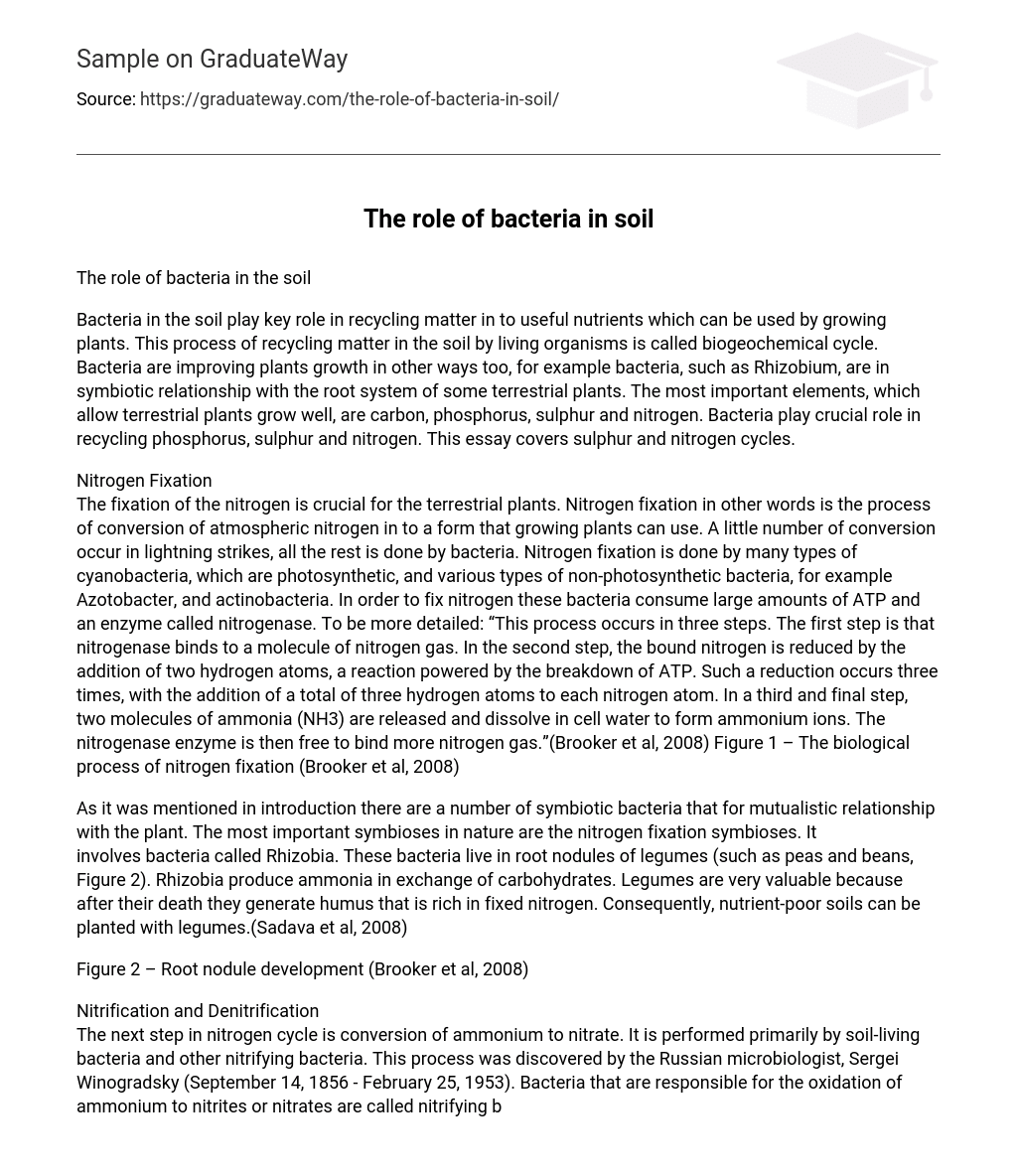The role of bacteria in the soil
Bacteria in the soil play key role in recycling matter in to useful nutrients which can be used by growing plants. This process of recycling matter in the soil by living organisms is called biogeochemical cycle. Bacteria are improving plants growth in other ways too, for example bacteria, such as Rhizobium, are in symbiotic relationship with the root system of some terrestrial plants. The most important elements, which allow terrestrial plants grow well, are carbon, phosphorus, sulphur and nitrogen. Bacteria play crucial role in recycling phosphorus, sulphur and nitrogen. This essay covers sulphur and nitrogen cycles.
Nitrogen Fixation
The fixation of the nitrogen is crucial for the terrestrial plants. Nitrogen fixation in other words is the process of conversion of atmospheric nitrogen in to a form that growing plants can use. A little number of conversion occur in lightning strikes, all the rest is done by bacteria. Nitrogen fixation is done by many types of cyanobacteria, which are photosynthetic, and various types of non-photosynthetic bacteria, for example Azotobacter, and actinobacteria. In order to fix nitrogen these bacteria consume large amounts of ATP and an enzyme called nitrogenase. To be more detailed: “This process occurs in three steps. The first step is that nitrogenase binds to a molecule of nitrogen gas. In the second step, the bound nitrogen is reduced by the addition of two hydrogen atoms, a reaction powered by the breakdown of ATP. Such a reduction occurs three times, with the addition of a total of three hydrogen atoms to each nitrogen atom. In a third and final step, two molecules of ammonia (NH3) are released and dissolve in cell water to form ammonium ions. The nitrogenase enzyme is then free to bind more nitrogen gas.”(Brooker et al, 2008) Figure 1 – The biological process of nitrogen fixation (Brooker et al, 2008)
As it was mentioned in introduction there are a number of symbiotic bacteria that for mutualistic relationship with the plant. The most important symbioses in nature are the nitrogen fixation symbioses. It involves bacteria called Rhizobia. These bacteria live in root nodules of legumes (such as peas and beans, Figure 2). Rhizobia produce ammonia in exchange of carbohydrates. Legumes are very valuable because after their death they generate humus that is rich in fixed nitrogen. Consequently, nutrient-poor soils can be planted with legumes.(Sadava et al, 2008)
Figure 2 – Root nodule development (Brooker et al, 2008)
Nitrification and Denitrification
The next step in nitrogen cycle is conversion of ammonium to nitrate. It is performed primarily by soil-living bacteria and other nitrifying bacteria. This process was discovered by the Russian microbiologist, Sergei Winogradsky (September 14, 1856 – February 25, 1953). Bacteria that are responsible for the oxidation of ammonium to nitrites or nitrates are called nitrifying bacteria. These bacteria can be divided into two groups. Bacteria that oxidize ammonia to nitrites are called Nitrosamonas. Nitrobacter represents the rather fewer genera which oxidize nitrite to nitrate. Ammonia or nitrite is less effective than nitrate because plants prefer nitrate. Nitrites are very toxic for plants, so it is crucial for nitrites to be converted to nitrates. The last stage in the nitrogen cycle is the reduction of nitrates into the nitrogen gas. This process occurs in anaerobic conditions with the help of bacteria such as Pseudomonas and Clostridium. These organisms use nitrate as an electron acceptor instead of oxygen. On the figure 2 it is straightaway recognized that bacteria are crucial in nitrogen cycle. They provide different forms of nitrogen for other organisms. (Postgate, 1998)
Figure 3- Nitrogen cycle
Phosphorus Cycle
Phosphorus is another soil mineral that often limits plant growth. Comparatively to the nitrogen cycle it is simple, however it is very slow. As you can see on the figure 4 bacteria play the key role in the phosphorus cycle. Bacteria decompose dead organisms and fossils making phosphorus available for the next steps of the cycle. Phosphorus is crucial for living
organisms because it is component of nucleic acids, bony structures, ATP and phospholipids. (White, 2003) Terrestrial plants take phosphorus from the ion known as phosphate. In the soil there are three dissolved forms of phosphate. The most commonly ion that is absorbed by plants is called hydrogen phosphate ion. Though phosphate is very abundant in the soil, in most cases it is unavailable to plants. It is important to mention here that soil bacteria also play a bad role by converting phosphate ions into organic compounds that are not absorbed by plants. The most common way to obtain phosphorus is the symbioses of plant roots with various types of fungi that release phosphorus from organic compounds. The process when phosphorus or nitrogen is released from organic compound is called mineralization. (Brooker et al, 2008)
Figure 4 – Phosphorus Cycle
Reference
Brooker et al. 2008. Biology, international edition., New York: The McGraw-Hill Companies, Inc.
Mary E. White, 2003. Earth Alive!: From Microbes to a Living Planet, Australia:Rosenberg Publishing.
Postgate, J. R. 1998. Nitrogen Fixation, 3rd edition. The Pitt Building, Cambridge: Cambridge University Press.
Sadava et al. 2008. Life: The Science of Biology, 8th ed., Gordonsville, Va.:W. H. Freeman ; Basingstoke :Palgrave
Smith, B., Richards, R. L., and Newton, W. E. 2004. Catalysts for nitrogen fixation: nitrogenases, relevant chemical models and commercial processes. Dordrecht: Kluwer Academic Publishers.
Figure 3 Accessed (04.2011) http://www.rothamsted.bbsrc.ac.uk/Research/Centres/Content.php?Section=Journe
yCentreEarth&Page=NitrogenCycle
Figure 4 Accessed (04.2011)
http://textbookofbacteriology.net/themicrobialworld/environmental.html





